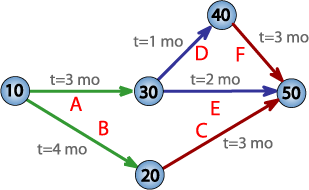Critical path method
From Wikipedia, the free encyclopedia
| This article may require cleanup to meet Wikipedia's quality standards. Please improve this article if you can. (December 2007) |

The Critical Path Method, abbreviated CPM, or Critical Path Analysis, is a mathematically based algorithm for scheduling a set of project activities. It is an important tool for effective project management.
It was developed in the 1950s by the US Navy when trying to better organize the building of submarines and later, especially, when building nuclear submarines. Today, it is commonly used with all forms of projects, including construction, software development, research projects, product development, engineering, and plant maintenance, among others. Any project with interdependent activities can apply this method of scheduling.
The essential technique for using CPM is to construct a model of the project that includes the following:
- A list of all activities required to complete the project (also known as Work breakdown structure),
- The time (duration) that each activity will take to completion, and
- The dependencies between the activities.
Using these values, CPM calculates the longest path of planned activities to the end of the project, and the earliest and latest that each activity can start and finish without making the project longer. This process determines which activities are "critical" (i.e., on the longest path) and which have "total float" (i.e., can be delayed without making the project longer). In project management, a critical path is the sequence of project network activities which add up to the longest overall duration. This determines the shortest time possible to complete the project. Any delay of an activity on the critical path directly impacts the planned project completion date (i.e. there is no float on the critical path). A project can have several, parallel, near critical paths. An additional parallel path through the network with the total durations shorter than the critical path is called a sub-critical or non-critical path.
These results allow managers to prioritize activities for the effective management of project completion, and to shorten the planned critical path of a project by pruning critical path activities, by "fast tracking" (i.e., performing more activities in parallel), and/or by "crashing the critical path" (i.e., shortening the durations of critical path activities by adding resources).
Originally, the critical path method considered only logical dependencies between terminal elements. Since then, it has been expanded to allow for the inclusion of resources related to each activity, through processes called activity-based resource assignments and resource leveling. A resource-leveled schedule may include delays due to resource bottlenecks (i.e., unavailability of a resource at the required time), and may cause a previously shorter path to become the longest or most "resource critical" path. A related concept is called the critical chain, which attempts to protect activity and project durations from unforeseen delays due to resource constraints.
Since project schedules change on a regular basis, CPM allows continuous monitoring of the schedule, allows the project manager to track the critical activities, and alerts the project manager to the possibility that non-critical activities may be delayed beyond their total float, thus creating a new critical path and delaying project completion. In addition, the method can easily incorporate the concepts of stochastic predictions, using the Program Evaluation and Review Technique (PERT) and event chain methodology.
Currently, there are several software solutions available in industry that use the CPM method of scheduling, see list of project management software. However, the method was developed and used without the aid of computers.
The Critical Path is similar to the method of PERT,both consist about times and the ending of the production, if Critical Path is modified, It won't work like a real administration tool.
A schedule generated using critical path techniques often is not realized precisely, as estimations are used to calculate times: if one mistake is made, the results of the analysis may change. This could cause an upset in the implementation of a project if the estimates are blindly believed, and if changes are not addressed promptly. However, the structure of critical path analysis is such that the variance from the original schedule caused by any change can be measured, and its impact either ameliorated or adjusted for. Indeed, an important element of project postmortem analysis is the As Built Critical Path (ABCP), which analyzes the specific causes and impacts of changes between the planned schedule and eventual schedule as actually implemented.
Contents |
[edit] Running Time
Given a graph G=G(N,E) of N nodes and E edges, if we use the Big O notation, the CPM algorithm takes O(E) to complete, since topological ordering of a graph takes O(E) and every edge is considered only twice, which means linear time in number of edges.
[edit] Literature
- Project Management Institute (2003). A Guide To The Project Management Body Of Knowledge (3rd ed.). Project Management Institute. ISBN 1-930699-45-X.
- Klastorin, Ted (2003). Project Management: Tools and Trade-offs (3rd ed.). Wiley. ISBN 978-0471413844.
- Heerkens, Gary (2001). Project Management (The Briefcase Book Series). McGraw-Hill. ISBN 0-07-137952-5.
- Kerzner, Harold (2003). Project Management: A Systems Approach to Planning, Scheduling, and Controlling (8th ed.). ISBN 0-471-22577-0.
- Lewis, James (2002). Fundamentals of Project Management (2nd ed.). American Management Association. ISBN 0-8144-7132-3.
- Lev Virine & Michael Trumper (2007). Project Decisions: The Art and Science. Management Concepts. ISBN 978-1567262179.
- Milosevic, Dragan Z. (2003). Project Management ToolBox: Tools and Techniques for the Practicing Project Manager. Wiley. ISBN 978-0471208228.
- Woolf, Murray B. (2007). Faster Construction Projects with CPM Scheduling. McGraw Hill. ISBN 978-0071486606.Critical Path method
[edit] See also
- Gantt chart
- List of project management software
- List of project management topics
- Program Evaluation and Review Technique
- Project
- Project management
- Project planning
- Work breakdown structure

